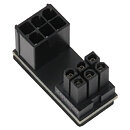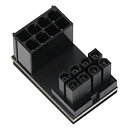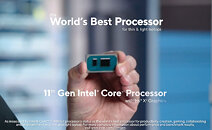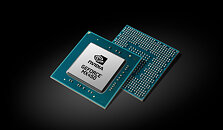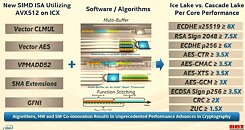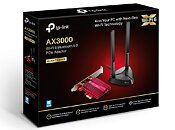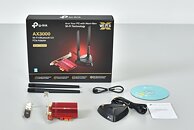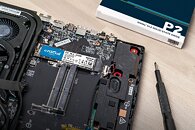Apr 24th, 2025 21:42 EDT
change timezone
Latest GPU Drivers
New Forum Posts
- Are the 8 GB cards worth it? (175)
- RTX 5070ti - Which MSRP model has the better/quieter cooler design, ASUS Prime, Gigabyte Windforce or PNY? (7)
- I tried to use AMD Auto Overclock, and now my PC has been freezing up sometimes. Afterwards, the screen goes black or displays artifacts. (29)
- random system shutdown with fans running at full speed (60)
- What's your latest tech purchase? (23594)
- Help getting a mini pc (9)
- New OLED monitor makes PC unresponsive sometimes (26)
- Your PC ATM (35362)
- TPU's Nostalgic Hardware Club (20278)
- What are you playing? (23461)
Popular Reviews
- NVIDIA GeForce RTX 5060 Ti 8 GB Review - So Many Compromises
- Crucial CUDIMM DDR5-6400 128 GB CL52 Review
- Colorful iGame B860M Ultra V20 Review
- ASUS GeForce RTX 5060 Ti TUF OC 16 GB Review
- Sapphire Radeon RX 9070 XT Pulse Review
- Upcoming Hardware Launches 2025 (Updated Apr 2025)
- Sapphire Radeon RX 9070 XT Nitro+ Review - Beating NVIDIA
- ASRock X870E Taichi Lite Review
- AMD Ryzen 7 9800X3D Review - The Best Gaming Processor
- ASUS GeForce RTX 5080 TUF OC Review
Controversial News Posts
- NVIDIA GeForce RTX 5060 Ti 16 GB SKU Likely Launching at $499, According to Supply Chain Leak (182)
- NVIDIA Sends MSRP Numbers to Partners: GeForce RTX 5060 Ti 8 GB at $379, RTX 5060 Ti 16 GB at $429 (127)
- NVIDIA Launches GeForce RTX 5060 Series, Beginning with RTX 5060 Ti This Week (115)
- Nintendo Confirms That Switch 2 Joy-Cons Will Not Utilize Hall Effect Stick Technology (105)
- Nintendo Switch 2 Launches June 5 at $449.99 with New Hardware and Games (99)
- Sony Increases the PS5 Pricing in EMEA and ANZ by Around 25 Percent (84)
- NVIDIA PhysX and Flow Made Fully Open-Source (77)
- Windows Notepad Gets Microsoft Copilot Integration (75)
News Posts matching #PCI-Express
Return to Keyword BrowsingQ.ANT Introduces First Commercial Photonic Processor
Q.ANT, the leading startup for photonic computing, today announced the launch of its first commercial product - a photonics-based Native Processing Unit (NPU) built on the company's compute architecture LENA - Light Empowered Native Arithmetics. The product is fully compatible with today's existing computing ecosystem as it comes on the industry-standard PCI-Express. The Q.ANT NPU executes complex, non-linear mathematics natively using light instead of electrons, promising to deliver at least 30 times greater energy efficiency and significant computational speed improvements over traditional CMOS technology. Designed for compute-intensive applications such as AI Inference, machine learning, and physics simulation, the Q.ANT NPU has been proven to solve real-world challenges, including number recognition for deep neural network inference (see the recent press release regarding Cloud Access to NPU).
"With our photonic chip technology now available on the standard PCIe interface, we're bringing the incredible power of photonics directly into real-world applications. For us, this is not just a processor—it's a statement of intent: Sustainability and performance can go hand in hand," said Dr. Michael Förtsch, CEO of Q.ANT. "For the first time, developers can create AI applications and explore the capabilities of photonic computing, particularly for complex, nonlinear calculations. For example, experts calculated that one GPT-4 query today uses 10 times more electricity than a regular internet search request. Our photonic computing chips offer the potential to reduce the energy consumption for that query by a factor of 30."
"With our photonic chip technology now available on the standard PCIe interface, we're bringing the incredible power of photonics directly into real-world applications. For us, this is not just a processor—it's a statement of intent: Sustainability and performance can go hand in hand," said Dr. Michael Förtsch, CEO of Q.ANT. "For the first time, developers can create AI applications and explore the capabilities of photonic computing, particularly for complex, nonlinear calculations. For example, experts calculated that one GPT-4 query today uses 10 times more electricity than a regular internet search request. Our photonic computing chips offer the potential to reduce the energy consumption for that query by a factor of 30."
Cervoz Launches Low-Profile USB Expansion with 8-Port and USB Type-A/C Versatility
Cervoz, a global leader in industrial-grade modules, proudly introduces its latest PCIe low-profile USB 3.2 expansion series—the MEC-USB-PL. Purpose-built to meet the rapidly growing demands for industrial connectivity, the MEC-USB-PL series is designed to offer unmatched flexibility and scalability, supporting up to 8 ports per card with both USB Type-A and Type-C connectors. The series delivers a robust and future-proof solution for a wide range of industrial applications, enabling seamless integration into modern, data-intensive operations.
Engineered for Industrial Performance and Reliability
The MEC-USB-PL series combines high port density with versatile configurations. Available in both 4-port and 8-port configurations, it allows industrial users to optimize connectivity setups based on specific needs. The 4-port model (MEC-USB-PL004) is ideal for applications needing focused, high-speed data transfer across devices, while the 8-port models (MEC-USB-PL008 and MEC-USB-PL008C) offer extensive connectivity. The MEC-USB-PL008C's mixed supporting of USB Type-A and Type-C enables compatibility across both legacy and modern devices.
Engineered for Industrial Performance and Reliability
The MEC-USB-PL series combines high port density with versatile configurations. Available in both 4-port and 8-port configurations, it allows industrial users to optimize connectivity setups based on specific needs. The 4-port model (MEC-USB-PL004) is ideal for applications needing focused, high-speed data transfer across devices, while the 8-port models (MEC-USB-PL008 and MEC-USB-PL008C) offer extensive connectivity. The MEC-USB-PL008C's mixed supporting of USB Type-A and Type-C enables compatibility across both legacy and modern devices.
ReBarUEFI is a Boot Time Module that Enables Resizable BAR on Some Older Platforms
Officially, support for resizable BAR on the Intel platform begins with the 10th Gen Core "Comet Lake," and for AMD, the Ryzen 3000 "Zen 2." It is a PCI-SIG feature that allows the software to see the entire amount of video memory on your graphics card as a single contiguous addressable block, rather than through 256 MB apertures—a workaround for the original PCI Express specification as the industry was transitioning to it from AGP. The PCI-SIG had introduced resizable BAR way back during the PCI-Express 2.0 specification (late 2000s), although none of the GPU or platform vendors of the time bothered to implement it. Resizable BAR is known to have a positive impact on performance for modern GPUs from NVIDIA and AMD; although its most profound performance impact is on the Intel Arc "Alchemist" GPUs, which suffer a large performance penalty without it.
ReBarUEFI by xCuri0 is a UEFI DXE driver mod, which requires you to know how to modify the UEFI firmware of your motherboard. The ReBarUEFI mod calls for a motherboard that implements UEFI, the older legacy BIOS won't do. The industry transitioned to UEFI in the early 2010s, roughly around the time of Intel "Sandy Bridge." UEFI DXE drivers provide basic support for the various hardware on your system. The ReBarUEFI driver informs software that the platform is capable of resizable BAR. Some motherboards may require you to enable the "Above 4G Decode" setting. The author claims that users on platforms as old as 2nd Gen Core "Sandy Bridge" have had success in getting resizable BAR to work.
ReBarUEFI by xCuri0 is a UEFI DXE driver mod, which requires you to know how to modify the UEFI firmware of your motherboard. The ReBarUEFI mod calls for a motherboard that implements UEFI, the older legacy BIOS won't do. The industry transitioned to UEFI in the early 2010s, roughly around the time of Intel "Sandy Bridge." UEFI DXE drivers provide basic support for the various hardware on your system. The ReBarUEFI driver informs software that the platform is capable of resizable BAR. Some motherboards may require you to enable the "Above 4G Decode" setting. The author claims that users on platforms as old as 2nd Gen Core "Sandy Bridge" have had success in getting resizable BAR to work.
Alphawave Semi Partners with Keysight to Deliver a Complete PCIe 6.0 Subsystem Solution
Alphawave Semi (LSE: AWE), a global leader in high-speed connectivity for the world's technology infrastructure, today announced successful collaboration with Keysight Technologies, a market-leading design, emulation, and test solutions provider, demonstrating interoperability between Alphawave Semi's PCIe 6.0 64 GT/s Subsystem (PHY and Controller) Device and Keysight PCIe 6.0 64 GT/s Protocol Exerciser, negotiating a link to the maximum PCIe 6.0 data rate. Alphawave Semi, already on the PCI-SIG 5.0 Integrators list, is accelerating next-generation PCIe 6.0 Compliance Testing through this collaboration.
Alphawave Semi's leading-edge silicon implementation of the new PCIe 6.0 64 GT/s Flow Control Unit (FLIT)-based protocol enables higher data rates for hyperscale and data infrastructure applications. Keysight and Alphawave Semi achieved another milestone by successfully establishing a CXL 2.0 link setting the stage for future cache coherency in the datacenter.
Alphawave Semi's leading-edge silicon implementation of the new PCIe 6.0 64 GT/s Flow Control Unit (FLIT)-based protocol enables higher data rates for hyperscale and data infrastructure applications. Keysight and Alphawave Semi achieved another milestone by successfully establishing a CXL 2.0 link setting the stage for future cache coherency in the datacenter.
Synopsys and Samsung Collaborate to Deliver Broad IP Portfolio Across All Advanced Samsung Foundry Processes
Synopsys, Inc. today announced an expanded agreement with Samsung Foundry to develop a broad portfolio of IP to reduce design risk and accelerate silicon success for automotive, mobile, high-performance computing (HPC) and multi-die designs. This agreement expands Synopsys' collaboration with Samsung to enhance the Synopsys IP offering for Samsung's advanced 8LPU, SF5, SF4 and SF3 processes and includes Foundation IP, USB, PCI Express, 112G Ethernet, UCIe, LPDDR, DDR, MIPI and more. In addition, Synopsys will optimize IP for Samsung's SF5A and SF4A automotive process nodes to meet stringent Grade 1 or Grade 2 temperature and AEC-Q100 reliability requirements, enabling automotive chip designers to reduce their design effort and accelerate AEC-Q100 qualification. The auto-grade IP for ADAS SoCs will include design failure mode and effect analysis (DFMEA) reports that can save months of development effort for automotive SoC applications.
"Our extensive co-optimization efforts with Samsung across both EDA and IP help automotive, mobile, HPC, and multi-die system architects cope with the inherent challenges of designing chips for advanced process technologies," said John Koeter, senior vice president of product management and strategy for IP at Synopsys. "This extension of our decades-long collaboration provides designers with a low-risk path to achieving their design requirements and quickly launching differentiated products to the market."
"Our extensive co-optimization efforts with Samsung across both EDA and IP help automotive, mobile, HPC, and multi-die system architects cope with the inherent challenges of designing chips for advanced process technologies," said John Koeter, senior vice president of product management and strategy for IP at Synopsys. "This extension of our decades-long collaboration provides designers with a low-risk path to achieving their design requirements and quickly launching differentiated products to the market."
PCIe 7.0 Specification, Version 0.3 Available to PCI-SIG Members
PCI-SIG is pleased to share the PCI Express (PCIe) 7.0 specification, version 0.3 is now available to members. Version 0.3 of the specification indicates that the first review draft of the specification is complete and has received work group approval. This is an important milestone for PCI-SIG, demonstrating we are on plan for a full specification release in 2025.
The PCIe 7.0 specification is targeted to support emerging applications such as 800 G Ethernet, AI/ML, Cloud and Quantum Computing; and data-intensive markets like Hyperscale Data Centers, High-Performance Computing (HPC), Edge and Military/Aerospace.
The PCIe 7.0 specification is targeted to support emerging applications such as 800 G Ethernet, AI/ML, Cloud and Quantum Computing; and data-intensive markets like Hyperscale Data Centers, High-Performance Computing (HPC), Edge and Military/Aerospace.

SilverStone Intros SX1000R Platinum SFX-L Power Supply
SilverStone today introduced the SX1000R Platinum, a 1000 W power supply in the SFX-L form-factor. The PSU meets SFX 12 V 4.0 (analogous to ATX 3.0), and PCI-Express Gen 5. It should offer identical power-delivery and excursion tolerance characteristics to a conventional ATX 3.0 + PCIe Gen 5-rated PSU. Internally, the SX1000R Platinum features a single +12 V rail design with a single 83.3 A rail, DC-to-DC switching to other voltage domains, and most common electrical protections, against over/under-voltage, overload, overheat, and short-circuit.
The PSU meets Cybenetics Platinum electrical switching efficiency ratings, Its 120 mm dual ball-bearing fan features idle fan-off as long as the load is under 200 W. Among the connectors provided by the SilverStone SX1000R Platinum are one 24-pin ATX, two 8-pin EPS, one 16-pin 12VHPWR with 600 W continuous power delivery capability, four 6+2 pin PCIe power, eight SATA power, three Molex, and one Berg. The company didn't reveal pricing or availability information.
The PSU meets Cybenetics Platinum electrical switching efficiency ratings, Its 120 mm dual ball-bearing fan features idle fan-off as long as the load is under 200 W. Among the connectors provided by the SilverStone SX1000R Platinum are one 24-pin ATX, two 8-pin EPS, one 16-pin 12VHPWR with 600 W continuous power delivery capability, four 6+2 pin PCIe power, eight SATA power, three Molex, and one Berg. The company didn't reveal pricing or availability information.

AMD Announces the $999 Radeon RX 7900 XTX and $899 RX 7900 XT, 5nm RDNA3, DisplayPort 2.1, FSR 3.0 FluidMotion
AMD today announced the Radeon RX 7900 XTX and Radeon RX 7900 XT gaming graphics cards debuting its next-generation RDNA3 graphics architecture. The two new cards come at $999 and $899—basically targeting the $1000 high-end premium price point.Both cards will be available on December 13th, not only the AMD reference design, which is sold through AMD.com, but also custom-design variants from the many board partners on the same day. AIBs are expected to announce their products in the coming weeks.The RX 7900 XTX is priced at USD $999, and the RX 7900 XT is $899, which is a surprisingly small difference of only $100, for a performance difference that will certainly be larger, probably in the 20% range. Both Radeon RX 7900 XTX and RX 7900 XT are using the PCI-Express 4.0 interface, Gen 5 is not supported with this generation. The RX 7900 XTX has a typical board power of 355 W, or about 95 W less than that of the GeForce RTX 4090. The reference-design RX 7900 XTX uses conventional 8-pin PCIe power connectors, as would custom-design cards, when they come out. AMD's board partners will create units with three 8-pin power connectors, for higher out of the box performance and better OC potential. The decision to not use the 16-pin power connector that NVIDIA uses was made "well over a year ago", mostly because of cost, complexity and the fact that these Radeons don't require that much power anyway.

ASUS Rolls Out PCE-AXE59BT PCIe Wi-Fi 6E + Bluetooth 5.2 WLAN Adapter
ASUS rolled out the PCE-AXE59BT WLAN adapter, ideal to update the wireless networking connectivity on your machine, if you lack an M.2 E-key slot. The low-profile PCI-Express x1 add-on card supports Wi-Fi 6E (802.11ax 6 GHz band), with data-rates of up to 2402 Mbps in the 6 GHz and 5 GHz radio bands; and up to 574 Mbps in the 2.4 GHz band. Besides Wi-Fi, the card also provides Bluetooth 5.2 connectivity. A pair of dual-MIMO antennae come included with the card. ASUS did not mention the manufacturer of the WLAN controller, and isn't listing drivers yet, so it could be either Intel or MediaTek. The company didn't reveal pricing, but it is expected to be around the $50-mark.

Jensen Confirms: NVLink Support in Ada Lovelace is Gone
NVIDIA CEO Jensen Huang in a call with the press today confirmed that Ada loses the NVLink connector. This marks the end of any possibility of explicit multi-GPU, and marks the complete demise of SLI (over a separate physical interface). Jensen stated that the reason behind removing the NVLink connector was because they needed the I/O for "something else," and decided against spending the resources to wire out an NVLink interface. NVIDIA's engineers also wanted to make the most out of the silicon area at their disposal to "cram in as much AI processing as we could". Jen-Hsun continued with "and also, because Ada is based on Gen 5, PCIe Gen 5, we now have the ability to do peer-to-peer cross-Gen 5 that's sufficiently fast that it was a better tradeoff". We reached out to NVIDIA to confirm and their answer is:
NVIDIAAda does not support PCIe Gen 5, but the Gen 5 power connector is included.
PCIe Gen 4 provides plenty of bandwidth for graphics usages today, so we felt it wasn't necessary to implement Gen 5 for this generation of graphics cards. The large framebuffers and large L2 caches of Ada GPUs also reduce utilization of the PCIe interface.

Thermaltake Rolls Out Toughpower GF3 PSUs with PCIe Gen 5 Connector and ATX 3.0 Compliance
Thermaltake today rolled out the Toughpower GF3 series high-wattage PSUs in the market, which it had unveiled early-July. These PSUs are claimed by Thermaltake to be ATX 3.0 ready, as well as include a PCI-Express Gen 5-compliant 12+4 pin connector that's capable of delivering up to 600 W of power with the ability to handle +100% excursions for at least 100 µs, making them ready for next-generation graphics cards and platforms. The Toughpower GF3 is being released in six wattages—1650 W, 1350 W, 1200 W, 1000 W, 850 W, and 750 W. The top 1650 W variant comes with two 12+4 pin PCIe Gen 5 connectors, while all lower models have one of them. These aside, the PSUs meet 80 Plus Gold efficiency standards, feature most common electrical protections, a multitude of standard 6+2 pin PCIe power connectors ranging from two on the 750 W model, to eight on the 1650 W one, at least two 8-pin EPS across the board, and 135 mm fans to keep cool.

MSI MEG Ai1300P and Ai1000P Power Supplies Leaked, Optimized for GPU Power Spikes
MSI is readying a line of high-end "smart" power supplies under the MEG Ai P-series. Some of the most relevant slides from its launch presentation were leaked to the web. courtesy g01d3nm4ng0. The PSUs feature ATX 3.0 and PCI-Express Gen 5.0 readiness, including native PCI-Express 16-pin 12VHPWR connectors that are capable of delivering 600 W of power. The lineup includes two models—the Ai1300P (1300 W), and Ai1000P (1000 W).
A key aspect of these PSUs' ATX 3.0 specification compliance is their ability to handle power excursions (spikes in load) from GPUs, ranging between 1 to 10 milliseconds in interval. Specifically, these PSUs can handle GPU power excursions that are up to 3x the nameplate load (eg: a GPU with 450 W typical power pulling 1350 W spikes). In some of the older PSUs, excursions are known to trigger the overload protection and shut down the system. The MSI MEG Ai P-series PSUs can handle excursions that are up to 2x the PSU's nameplate capacity (eg: 2600 W for the 1300 W model); and 3x that of the 16-pin connector (i.e. 1800 W). These spikes typically have a extremely narrow interval, and so they don't threaten the integrity of the circuits.
A key aspect of these PSUs' ATX 3.0 specification compliance is their ability to handle power excursions (spikes in load) from GPUs, ranging between 1 to 10 milliseconds in interval. Specifically, these PSUs can handle GPU power excursions that are up to 3x the nameplate load (eg: a GPU with 450 W typical power pulling 1350 W spikes). In some of the older PSUs, excursions are known to trigger the overload protection and shut down the system. The MSI MEG Ai P-series PSUs can handle excursions that are up to 2x the PSU's nameplate capacity (eg: 2600 W for the 1300 W model); and 3x that of the 16-pin connector (i.e. 1800 W). These spikes typically have a extremely narrow interval, and so they don't threaten the integrity of the circuits.
MediaTek Unveils New AIoT Platform Stack and Introduces the Genio 1200 AIoT Chip
MediaTek today unveiled its new Genio platform for AIoT devices and introduced the first chip in the Genio family, the Genio 1200 designed for premium AIoT products. MediaTek Genio is a complete platform stack for the AIoT with powerful and ultra- efficient chipsets, open platform software development kits (SDKs) and a developer portal with comprehensive resources and tools. This all-in-one platform makes it easy for brands to develop innovative consumer, enterprise and industrial smart applications at the premium, mid-range and entry levels, and bring these devices to market faster. With MediaTek Genio, customers have access to all the hardware, software and resources needed to go from concept to design and manufacturing.
Customers can choose from a range of Genio chips to suit their product needs, and then use MediaTek's developer resources and the Yocto Linux open platform SDK to customize their designs. MediaTek also makes it easy for customers to access its partners' system hardware and software, and leverage partners' networks and sales channels. By offering an integrated, easy-to-use platform, MediaTek Genio reduces development costs and speeds up time to market, while providing long-term support for operating system updates and security patches that extend the product lifecycle. "Today MediaTek powers the most popular AIoT devices on the market. As the industry enters the next era of innovation, MediaTek's Genio platform delivers flexibility, scalability and development support brands need to cater to the latest market demands," said Jerry Yu, MediaTek Corporate Senior Vice President and General Manager of MediaTek's Computing, Connectivity and Metaverse Business Group. "We look forward to seeing the new user experiences brands bring to life with the Genio 1200 and its powerful AI capability, support for 4K displays and advanced imaging features."
Customers can choose from a range of Genio chips to suit their product needs, and then use MediaTek's developer resources and the Yocto Linux open platform SDK to customize their designs. MediaTek also makes it easy for customers to access its partners' system hardware and software, and leverage partners' networks and sales channels. By offering an integrated, easy-to-use platform, MediaTek Genio reduces development costs and speeds up time to market, while providing long-term support for operating system updates and security patches that extend the product lifecycle. "Today MediaTek powers the most popular AIoT devices on the market. As the industry enters the next era of innovation, MediaTek's Genio platform delivers flexibility, scalability and development support brands need to cater to the latest market demands," said Jerry Yu, MediaTek Corporate Senior Vice President and General Manager of MediaTek's Computing, Connectivity and Metaverse Business Group. "We look forward to seeing the new user experiences brands bring to life with the Genio 1200 and its powerful AI capability, support for 4K displays and advanced imaging features."

Intel "Arctic Sound M" Enterprise Accelerator Shown Encoding AV1 Video
Intel showed off the video encode acceleration capabilities of its upcoming Data Center GPU codenamed "Arctic Sound M," which features AV1 video encode hardware-acceleration. Intel has been pushing for AV1 to be adopted as the streaming video standard for some years now, as it offers comparable bitrate savings and quality to H.265, but is royalty free, resulting in tens of millions of Dollars of royalty savings for streaming content providers such as Netflix, as well as consumer electronics manufacturers, particularly smart TV makers.
Intel's accelerator is a single-slot, full-height add-on card with a PCI-Express x16 interface. It relies on rack airflow for cooling, and features a metal-channel heatsink. Power is drawn from a single 8-pin PCIe power connector. There are no encoding performance numbers put out, except the 30% bitrate savings AV1 offers compared to the current industry standard, H.264. This 30% saving adds up in a big way for a streaming content provider.Intel's video presentation follows.
Intel's accelerator is a single-slot, full-height add-on card with a PCI-Express x16 interface. It relies on rack airflow for cooling, and features a metal-channel heatsink. Power is drawn from a single 8-pin PCIe power connector. There are no encoding performance numbers put out, except the 30% bitrate savings AV1 offers compared to the current industry standard, H.264. This 30% saving adds up in a big way for a streaming content provider.Intel's video presentation follows.

PSA: GPU-Z shows PCI-Express x16 for Radeon RX 6500 XT / Navi 24. It really is x4
AMD announced the Radeon RX 6500 XT and RX 6400 at CES just a few days ago. These new entry-level cards debut the company's first 6 nm GPU, codenamed "Navi 24"—the smallest chip from the RDNA2 family. Navi 24 is barely the size of a motherboard chipset, roughly 100 mm² in die size. The chip only features a 64-bit wide GDDR6 memory interface, needing just two memory chips to achieve 4 GB of memory size. While AMD has been fairly quiet about it, people quickly found out that the Navi 24 GPU only uses a PCI-Express 4.0 x4 host interface. While the physical connector is x16, there is only enough signal traces for x4.Even the most updated 2.43.0 public version of GPU-Z misreports the bus interface as PCIe x16 4.0 though, which will certainly lead to confusion in the reviewer community who trust GPU-Z to report the correct specs and speeds for their articles. Maybe that's the reason why AMD has decided to not send us a sample this time—a first in 15 years.
Update Jan 20th: GPU-Z 2.44.0 has been released, which properly reports the PCIe bus configuration of RX 6500 XT.
Update Jan 20th: GPU-Z 2.44.0 has been released, which properly reports the PCIe bus configuration of RX 6500 XT.
PCI-SIG Releases PCIe 6.0 Specification: 64 GT/s Per Lane
PCI-SIG, the organization responsible for the widely adopted PCI Express (PCIe ) standard, today announced the official release of the PCIe 6.0 specification, reaching 64 GT/s. PCI Express technology has served as the de facto interconnect of choice for nearly two decades. The PCIe 6.0 specification doubles the bandwidth and power efficiency of the PCIe 5.0 specification (32 GT/s), while providing low latency and reduced bandwidth overhead.
"PCI-SIG is pleased to announce the release of the PCIe 6.0 specification less than three years after the PCIe 5.0 specification," said Al Yanes, PCI-SIG Chairperson and President. "PCIe 6.0 technology is the cost-effective and scalable interconnect solution that will continue to impact data-intensive markets like data center, artificial intelligence/machine learning, HPC, automotive, IoT, and military/aerospace, while also protecting industry investments by maintaining backwards compatibility with all previous generations of PCIe technology."
"PCI-SIG is pleased to announce the release of the PCIe 6.0 specification less than three years after the PCIe 5.0 specification," said Al Yanes, PCI-SIG Chairperson and President. "PCIe 6.0 technology is the cost-effective and scalable interconnect solution that will continue to impact data-intensive markets like data center, artificial intelligence/machine learning, HPC, automotive, IoT, and military/aerospace, while also protecting industry investments by maintaining backwards compatibility with all previous generations of PCIe technology."

AMD and GlobalFoundries Renew Wafer Supply Agreement
AMD in its 8-K filing with the SEC, disclosed that it has updated its wafer supply agreement (WSA) with GlobalFoundries. Under the latest agreement, AMD commits to buy $2.1 billion worth wafers from GlobalFoundries between 2022 and 2025. The previous version of the WSA saw commitments up to 2024, and wafers worth $1.6 billion. The update hence adds another year and $500 million worth supply.
AMD currently sources 12 nm and 14 nm wafers from GlobalFoundries, which go into making cIOD and sIOD components in its processors, and motherboard chipsets. The move to extend the WSA indicates that the company may continue to use 12 nm-class I/O dies in its processors for the foreseeable future. It will be very interesting to see if 12 nm-class I/O dies make it to next-generation products such as "Genoa" and "Rapael," which integrate the latest IP blocks such as PCI-Express Gen 5 root-complexes, DDR5 memory controllers, and 3rd Gen Infinity Fabric. Processors with 12 nm I/O dies, such as "Milan" and "Vermeer" could be retired only by 2023-24, as AMD will use 2022 to spread across its next-gen product launches.
AMD currently sources 12 nm and 14 nm wafers from GlobalFoundries, which go into making cIOD and sIOD components in its processors, and motherboard chipsets. The move to extend the WSA indicates that the company may continue to use 12 nm-class I/O dies in its processors for the foreseeable future. It will be very interesting to see if 12 nm-class I/O dies make it to next-generation products such as "Genoa" and "Rapael," which integrate the latest IP blocks such as PCI-Express Gen 5 root-complexes, DDR5 memory controllers, and 3rd Gen Infinity Fabric. Processors with 12 nm I/O dies, such as "Milan" and "Vermeer" could be retired only by 2023-24, as AMD will use 2022 to spread across its next-gen product launches.

SSUPD and TechPowerUp Present Meshlicious Giveaway
SSUPD are experts with compact, well-ventilated gaming PC cases, made with premium materials. The company partners with TechPowerUp to bring you the SSUPD x TechPowerUp Meshlicious Giveaway, open to residents of Canada and the Continental US. There are six prizes up for grabs, four Full Mesh Meshlicious White with PCI-Express Gen4 riser cable; and two Mesh Meshlicious Black with tempered glass side-panel, and PCI-Express Gen3 riser. The Meshlicious cases are a family of compact, tower-type SFF gaming PC cases designed for high-end hardware, including full-length enthusiast graphics cards, AIO CLC cooling with radiators as big as 280 mm; and a sturdy construction with mesh panels at just the right spots for high airflow. To win, simply fill up a short form to help us get back to you if you've won. Good Luck!
For more information and to participate, visit this page.
For more information and to participate, visit this page.
Ainex Releases Ingenious GPU Power Cable Hider Adapter
Japanese company Ainex has recently announced an ingenious solution to hide GPU PCI-Express power cables by reversing the orientation of the power cable. The adapters feature a compact size so can be used in parallel for power-intensive devices, the adapters are available in upper and lower latch versions to accommodate all cards. Ainex is offering 4 models for 6 and 8 pin connectors ranging from 600 - 700 yen (~6-7 USD) with shipping starting on November 25. The adapters are unlikely to see an official international release however you can likely import the item or find similar products online.

Intel 11th Gen Core "Tiger Lake" & Xe Graphics Launch Event: Live Blog
Intel today launches its 11th Gen Core "Tiger Lake" mobile processors that introduce several new technologies on the backs of new IP. As described in the Architecture Day, "Tiger Lake" is built on the 10 nm SuperFin process, and combines new "Willow Cove" CPU cores with the first commercial debut of the Xe Gen12 graphics architecture that Intel is betting big on, to make a stab at the consumer graphics and scalar compute markets. Join us in this live-blog.Update 16:00 UTC: GB (Gregory Bryant, EVP Client), leads the event from the comfort of his home.Update 16:04 UTC: Here it is, the "world's best processor for thin and light laptops. You'll notice that like most Intel U-segment chips, this is an MCM of the processor and PCH die. Intel bases its "world's best" claims on a per-segment basis.

NVIDIA Releases GeForce MX450 with PCI-Express 4.0 Interface
NVIDIA released a mysterious new mobile GPU that has us scratching our heads over the silicon that could be driving it. The new GeForce MX450 is an entry-mainstream mobile GPU that apparently ships with a PCI-Express gen 4.0 bus interface, something only NVIDIA's "Ampere" GPUs feature. The product page for the MX450 doesn't list out any other specs, than its memory type support including new GDDR6 memory (supported only on NVIDIA architectures "Turing" or later). Interestingly, it also lists GDDR5 as one of its memory options. PCI-Express 4.0 is prominently listed as one of its specs.
Upon digging some more among device IDs, we've come across the ID of the GDDR5 variant, with the ASIC code "GP107-670-A1," and the silicon is based on the much older "Pascal" architecture, which lacks PCIe gen 4 support. The GDDR6 variant eludes us. This is the SKU which could be based on a newer architecture, given its support for GDDR6 and PCIe gen 4. NVIDIA's GeForce MX line of entry-mainstream mobile GPUs are built to performance/power targets, and wildly vary with the underlying tech. They've been historically a means for NVIDIA to clear inventory of older generation ASICs to notebook manufacturers, who get put the NVIDIA logo on their products, and advertise discrete graphics. Given this, the use of a newer (even unreleased) generation of GPUs comes as a surprise.
Upon digging some more among device IDs, we've come across the ID of the GDDR5 variant, with the ASIC code "GP107-670-A1," and the silicon is based on the much older "Pascal" architecture, which lacks PCIe gen 4 support. The GDDR6 variant eludes us. This is the SKU which could be based on a newer architecture, given its support for GDDR6 and PCIe gen 4. NVIDIA's GeForce MX line of entry-mainstream mobile GPUs are built to performance/power targets, and wildly vary with the underlying tech. They've been historically a means for NVIDIA to clear inventory of older generation ASICs to notebook manufacturers, who get put the NVIDIA logo on their products, and advertise discrete graphics. Given this, the use of a newer (even unreleased) generation of GPUs comes as a surprise.

Intel Xeon Scalable "Ice Lake-SP" 28-core Die Detailed at Hot Chips - 18% IPC Increase
Intel in the opening presentation of the Hot Chips 32 virtual conference detailed its next-generation Xeon Scalable "Ice Lake-SP" enterprise processor. Built on the company's 10 nm silicon fabrication process, "Ice Lake-SP" sees the first non-client and non-mobile deployment of the company's new "Sunny Cove" CPU core that introduces higher IPC than the "Skylake" core that's been powering Intel microarchitectures since 2015. While the "Sunny Cove" core itself is largely unchanged from its implementation in 10th Gen Core "Ice Lake-U" mobile processors, it conforms to the cache hierarchy and tile silicon topology of Intel's enterprise chips.
The "Ice Lake-SP" die Intel talked about in its Hot Chips 32 presentation had 28 cores. The "Sunny Cove" CPU core is configured with the same 48 KB L1D cache as its client-segment implementation, but a much larger 1280 KB (1.25 MB) dedicated L2 cache. The core also receives a second fused multiply/add (FMA-512) unit, which the client-segment implementation lacks. It also receives a handful new instruction sets exclusive to the enterprise segment, including AVX-512 VPMADD52, Vector-AES, Vector Carry-less Multiply, GFNI, SHA-NI, Vector POPCNT, Bit Shuffle, and Vector BMI. In one of the slides, Intel also detailed the performance uplifts from the new instructions compared to "Cascade Lake-SP".
The "Ice Lake-SP" die Intel talked about in its Hot Chips 32 presentation had 28 cores. The "Sunny Cove" CPU core is configured with the same 48 KB L1D cache as its client-segment implementation, but a much larger 1280 KB (1.25 MB) dedicated L2 cache. The core also receives a second fused multiply/add (FMA-512) unit, which the client-segment implementation lacks. It also receives a handful new instruction sets exclusive to the enterprise segment, including AVX-512 VPMADD52, Vector-AES, Vector Carry-less Multiply, GFNI, SHA-NI, Vector POPCNT, Bit Shuffle, and Vector BMI. In one of the slides, Intel also detailed the performance uplifts from the new instructions compared to "Cascade Lake-SP".

Intel "Alder Lake-S" Confirmed to Introduce LGA1700 Socket, Technical Docs Out for Partners
Intel's Core "Alder Lake-S" desktop processor, which succeeds the 11th generation "Rocket Lake-S," is confirmed to introduce a new CPU socket, LGA1700. This new socket has been churning in the rumor mill since 2019. The LGA1700 socket is Intel's biggest mainstream desktop processor package change since LGA1156, in that the package is now physically larger, and may be cooler-incompatible with LGA115x sockets (Intel H# sockets). The enlargement in package size is seen as an attempt by Intel to give itself real-estate to build future multi-chip modules; while the increased pin-count points to the likelihood of more I/O centralization to the processor package.
The "Alder Lake-S" silicon is rumored to be Intel's first 10 nm-class mainstream desktop processor, combining a hybrid core setup of a number of "Golden Cove" high-performance CPU cores, and a number of "Gracemont" low-power cores. The processor's I/O feature-set is expected to include dual-channel DDR5 memory, PCI-Express gen 4.0, and possibly preparation for gen 5.0 on the motherboard-side. In related news, Intel put out technical documentation for the "Alder Lake-S" microarchitecture and LGA1700 socket. Access however, is restricted to Intel's industrial partners. The company also put out documentation for "Rocket Lake-S."
The "Alder Lake-S" silicon is rumored to be Intel's first 10 nm-class mainstream desktop processor, combining a hybrid core setup of a number of "Golden Cove" high-performance CPU cores, and a number of "Gracemont" low-power cores. The processor's I/O feature-set is expected to include dual-channel DDR5 memory, PCI-Express gen 4.0, and possibly preparation for gen 5.0 on the motherboard-side. In related news, Intel put out technical documentation for the "Alder Lake-S" microarchitecture and LGA1700 socket. Access however, is restricted to Intel's industrial partners. The company also put out documentation for "Rocket Lake-S."

TP-Link Intros Archer TX3000E 802.11ax PCIe WLAN Card
For those of us on older desktops with plenty of PCIe slots to go around, and a brand new 802.11ax router in the house to drive a swanky new gigabit fiber Internet connection, TP-Link released the Archer TX3000E, a PCI-Express add-on card that gives your desktop 802.11ax Wi-Fi 6 and Bluetooth 5.0 connectivity. The product consists of three components, the add-on card, an antenna assembly, and cabling. The add-on card features PCI-Express 2.0 x1 (5 Gbps per direction) host interface, and uses an Intel AX200 WLAN controller that's passively cooled by a heatsink.
The Archer TX3000E supports dual-band 802.11ax, with up to 2402 Mbps on the 5 GHz band, and up to 574 Mbps in the 2.4 GHz band, along with support for WPA3. Besides PCIe, a 4-pin USB 2.0 cable connects to one of your motherboard's vacant USB 2.0 headers, for the Bluetooth 5.0 component to work. The desktop antenna assembly features two multi-directional antennae, and a magnetized base. Available now, the Archer TX3000E is priced at 79.90€.
The Archer TX3000E supports dual-band 802.11ax, with up to 2402 Mbps on the 5 GHz band, and up to 574 Mbps in the 2.4 GHz band, along with support for WPA3. Besides PCIe, a 4-pin USB 2.0 cable connects to one of your motherboard's vacant USB 2.0 headers, for the Bluetooth 5.0 component to work. The desktop antenna assembly features two multi-directional antennae, and a magnetized base. Available now, the Archer TX3000E is priced at 79.90€.

Crucial P2 Announced: Company's Second QLC M.2 NVMe Client SSD
Here's the first picture of the Crucial P2, the company's second M.2 NVMe client SSD series based on QLC NAND flash memory, and successor to the Crucial P1. The drive sticks to PCI-Express gen 3.0 x4 as its host interface, but increases sequential read speeds over the P1. Available in 250 GB and 500 GB models to begin with, the P2 offers sequential transfer rates of up to 2100 MB/s reads with up to 1150 MB/s writes for the 250 GB variant; and up to 2300 MB/s reads with up to 940 MB/s writes on the 500 GB variant. There's no word on whether the P2 uses the same QLC NAND chips as the P1, but we do spy a DRAM cache chip. Endurance of the P2 is rated at 150 TBW, and Crucial is backing them with 5-year warranties when they come out in the near future. Pricing in Europe is expected to be about 59€ for the 250 GB model, and 70€ for the 500 GB one.
Update 15:54 UTC: Crucial launched the drive Stateside at $54.99 for the 250 GB model, and $64.99 for the 500 GB model. We've added more images.
Update 15:54 UTC: Crucial launched the drive Stateside at $54.99 for the 250 GB model, and $64.99 for the 500 GB model. We've added more images.
Apr 24th, 2025 21:42 EDT
change timezone
Latest GPU Drivers
New Forum Posts
- Are the 8 GB cards worth it? (175)
- RTX 5070ti - Which MSRP model has the better/quieter cooler design, ASUS Prime, Gigabyte Windforce or PNY? (7)
- I tried to use AMD Auto Overclock, and now my PC has been freezing up sometimes. Afterwards, the screen goes black or displays artifacts. (29)
- random system shutdown with fans running at full speed (60)
- What's your latest tech purchase? (23594)
- Help getting a mini pc (9)
- New OLED monitor makes PC unresponsive sometimes (26)
- Your PC ATM (35362)
- TPU's Nostalgic Hardware Club (20278)
- What are you playing? (23461)
Popular Reviews
- NVIDIA GeForce RTX 5060 Ti 8 GB Review - So Many Compromises
- Crucial CUDIMM DDR5-6400 128 GB CL52 Review
- Colorful iGame B860M Ultra V20 Review
- ASUS GeForce RTX 5060 Ti TUF OC 16 GB Review
- Sapphire Radeon RX 9070 XT Pulse Review
- Upcoming Hardware Launches 2025 (Updated Apr 2025)
- Sapphire Radeon RX 9070 XT Nitro+ Review - Beating NVIDIA
- ASRock X870E Taichi Lite Review
- AMD Ryzen 7 9800X3D Review - The Best Gaming Processor
- ASUS GeForce RTX 5080 TUF OC Review
Controversial News Posts
- NVIDIA GeForce RTX 5060 Ti 16 GB SKU Likely Launching at $499, According to Supply Chain Leak (182)
- NVIDIA Sends MSRP Numbers to Partners: GeForce RTX 5060 Ti 8 GB at $379, RTX 5060 Ti 16 GB at $429 (127)
- NVIDIA Launches GeForce RTX 5060 Series, Beginning with RTX 5060 Ti This Week (115)
- Nintendo Confirms That Switch 2 Joy-Cons Will Not Utilize Hall Effect Stick Technology (105)
- Nintendo Switch 2 Launches June 5 at $449.99 with New Hardware and Games (99)
- Sony Increases the PS5 Pricing in EMEA and ANZ by Around 25 Percent (84)
- NVIDIA PhysX and Flow Made Fully Open-Source (77)
- Windows Notepad Gets Microsoft Copilot Integration (75)








































